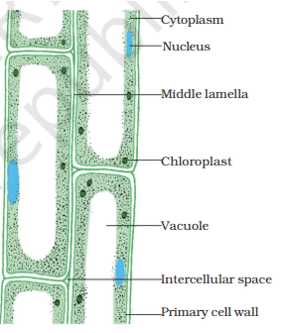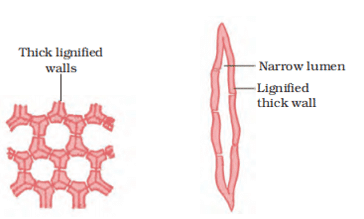
Hello everyone, here you will get the important questions from Chapter 6 Tissues Class 9 Science. Prepare all these questions from the Tissues Chapter to score maximum in your exam.
Q. No. 1) Why are voluntary muscles called skeletal muscles?
Ans. Voluntary muscles are also called skeletal muscles because they are mostly attached to the bones and help in body movement.
Q. No. 2) What are the functions of the stomata?
Ans. i. Transpiration
ii. Exchange of gases with the atmosphere.
Q. No. 3) In desert plant, how does the rate of loss of water gets reduced?
Ans. The presence of cuticles on the surface of desert plants reduces the rate of loss of water.
Q. No. 4) Define the process of differentiation.
Ans. The loss of ability to divide by taking up a permanent shape, size, and function is called differentiation.
Q. No. 5) What is the location of stratified squamous epithelium? Also, mention its functions.
Ans. Stratified squamous epithelium is found in the skin. They are present in layers to prevent wear and tear.
Q. No. 6) Fill in the blanks:
a. ________ are forms of complex tissue.
b. ________ have guard cells.
c. Cells of cork contain a chemical called ________.
d. Husk of coconut is made of ________ tissue.
e. ________ gives flexibility in plants.
f. ________ and ________ are both conducting tissues.
g. Xylem transports ________ and ________ from soil.
h. Phloem transport ________ from ________ to other parts of the plant.
Ans.
a. Xylem and phloem
f. Xylem and phloem
g. Water and minerals
Q. No. 7) Tissue A and tissue B constitute tissue C. A carries water while B carries food for the plants. Identify A, B, and C.
Ans. A – Xylem, B – Phloem, C – Vascular bundles/Complex permanent tissue.
Q. No. 8) Give reasons for:
a. Meristematic cells have a prominent nucleus and dense cytoplasm but they lack vacuole.
b. Intercellular spaces are absent in sclerenchyma tissues.
c. We get a crunchy and granular feeling when we chew pear fruit.
d. Branches of a tree move and bend freely in high wind velocity.
e. It is difficult to pull out the husk of a coconut tree.
Ans.
a. Vacuoles basically serve the purpose of storing of nutrients, excess salts, etc. Meristematic cells do not need to store these nutrients. They are specialized cells. Their main role is to divide and grow. Hence, they are very active, and have dense cytoplasm, and prominent nuclei, but they lack vacuoles.
b. Cells of sclerenchyma tissue have thick cell walls due to lignin. Due to the thick cell wall, intercellular spaces are absent in sclerenchyma tissue.
c. In pear fruit, sclerenchyma cells are called stone cells. They are small, thick, and hard. That is why we get a crunchy and granular feeling when we chew pear fruit.
d. Branches of a tree move and bend freely in high wind velocity due to the presence of a permanent tissue called collenchyma. Collenchyma provides flexibility in plants. It allows the bending of various parts of a plant.
e. The husk of a coconut tree contains sclerenchyma tissue. This tissue makes the plant hard and stiff. That is why it is difficult to pull out the husk of a coconut tree.
Q. No. 9) The root tips of a plant were cut and the plant was replanted. What will happen to the plant and why?
Ans. The plant will die within a few days of replanting it. This is because since the root tips are cut, the roots won’t grow because of the absence of meristematic tissue. And if the roots will not grow, proper absorption of water and minerals will not occur.
Q. No. 10) List the characteristics of cork. How are they formed? Mention their role.
Ans.
Characteristics of cork:
a. Cells of cork are dead at maturity.
b. These cells are compactly arranged.
c. Cells do not possess intercellular spaces.
d. Cells possess the chemical substance suberin in their walls.
e. They are several layers thick.
Formation of Cork:
As plants grow older, a strip of secondary meristem replaces the epidermis of the stem. Cells cut on the outer side by this meristem are called cork.
a. They are protective in function for older stem/twigs/branches.
b. They are impervious to gases and water.
Q. No. 11) Differentiate between Tendon and ligament.
Ans.
| Tendon | Ligament |
| 1. Tendons help in connecting bones to muscles. | 1. Ligaments help in connecting bones to bones. |
| 2. It is strong and non-flexible. | 2. It is elastic and flexible. |
Q. No. 12) Explain with the help of a diagram, the location, and function of meristematic tissue.
Ans.
| Type | Location | Function |
| i. Apical Meristem | Growing tips of shoot and root. | Increases the length of the plant. |
| ii. Lateral Meristem | On sides of stem and root. | Increases the girth of stem and root. |
| iii. Intercalary Meristem | At the base of leaves or internodes. | Increases the length of leaves and internodes. |

Q. No. 13) Why are plants and animals made up of different types of tissues?
Ans. Plants and animals are two different types of organisms. There are noticeable differences in structure and function between the two.
a. Plants are stationary or fixed, so they have a large quantity of supportive tissue. The supportive tissue generally has dead cells. Animals on the other hand move around in search of food, mates, and shelter. Most of the tissues they contain are living.
b. The growth in plants is limited to certain regions. Based on the dividing capacity, plant tissues are classified as meristematic and permanent tissue. Cell growth in animals is more uniform. So, there is no such demarcation of dividing and non-dividing regions in animals.
c. Plants are autotrophic organisms. Animals on the other hand are heterotrophic organisms.
Because of the above differences, plants and animals are made of different types of tissues.
Q. No. 14) Give the difference between the types of muscle fibers diagrammatically.
Ans.
| Striated | Smooth | Cardiac |
| 1. Attached to bones. | 1. They are present in the alimentary canal, in the iris of the eye, in the ureters, lungs. | 1. They are present in the heart. |
| 2. They are voluntary muscles. | 2. They are involuntary muscles. | 2. They are involuntary muscles. |
| 3. Multinucleate | 3. Uninucleate | 3. Uninucleate |
| 4. The cells of this tissue are long, cylindrical, and unbranched. | 4. The cells are long with pointed ends. (spindle-shaped) | 4. The cells are cylindrical, and branched. |
 |  |  |
Q. No. 15) What are the two main components of blood? Why is blood considered a type of connective tissue?
Ans. Components of blood:
a. Fluid (liquid) matrix called plasma.
b. Suspended red blood cells (RBCs), white blood cells (WBCs), and platelets.
Blood is considered a connective tissue because:
a. It has the same origin as the other connective tissues.
b. It flows to different parts of the body and thus connects different parts of the body with one another to exchange materials and gases.
Q. No. 16) Differentiate between meristematic and permanent tissues in plants.
Ans.
| Meristematic Tissue | Permanent Tissue |
| 1. Cells of this tissue divide throughout their life. | 1. They lose the ability to divide to take up specific functions. |
| 2. They are located at specific regions of the plant viz: apical, later, intercalary. | 2. They are distributed throughout the plant body. |
| 3. Cells of this tissue are very active and have dense cytoplasm, thin walls, and prominent nuclei. They lack vacuoles. | 3. They are vacuolated and vary in shape and size. Their cell wall may be thick. |
| 4. Cell wall is made up of cellulose. | 4. Cell wall is made up of cellulose/lignin/suberin. |
Q. No. 17) Why are xylem and phloem called complex tissues? How are they different from one another?
Ans. Both xylem and phloem consist of more than one type of cell, which coordinates to perform a common function.
| Xylem | Phloem |
| 1. Consists of tracheids, vessels, xylem parenchyma, and xylem fibres. | 1. Consist of sieve cells, sieve tubes, companion cells, phloem fibres, and phloem parenchyma. |
| 2. They transport water and minerals vertically from soil to aerial parts of the plant. | 2. They transport food from leaves to other parts of the plant. |
| 3. Most of the cells except xylem parenchyma are dead cells. | 3. Most of the cells except phloem fibres are living cells. |
Q. No. 18) Differentiate between sclerenchyma and parenchyma tissues. Draw a well-labeled diagram.
Ans.
| Parenchyma | Sclerenchyma |
| 1. Cells are thin-walled and unspecialized. | 1. Cells are thick-walled and specialized. |
| 2. These are living cells. | 2. Tissues are made up of dead cells. |
| 3. Cells are usually loosely packed with large intercellular space. | 3. No intercellular spaces between the cells are found. |
| 4. Stores nutrients and water in stem and roots. | 4. Provides strength to the plant parts. |
  |  |
Q. No. 19) Match column (A) with column (B)
| (A) | (B) |
| a. Fluid connective tissue | i. Fat storing |
| b. Filling of space inside organs | ii. Cartilage |
| c. Striated muscles | iii. Skeletal muscle |
| d. Adipose tissue | iv. Areolar tissue |
| e. The surface of joints | v. Blood |
| f. Stratified squamous epithelium | vi. Skin |
Ans. a - v; b - iv; c - iii; d - i; e - ii; f - vi
Q. No. 20) Identify the tissues:
a. Tissue that forms the inner lining of our mouth.
b. Tissue that connects muscle to bone in humans.
c. Tissue that transports food in plants.
d. Tissue that stores fat in our body.
e. Connective tissue with a fluid matrix.
f. Tissue present in the brain.
Ans. a. Simple squamous epithelium
d. Adipose tissue
f. Nervous tissue.
Q. No. 21) Draw a labeled diagram of a neuron.
Ans.

** In addition to the above-given questions, also prepare the questions given in the NCERT Textbook.
Do Watch the Full Chapter Detailed Explanation of this chapter here: